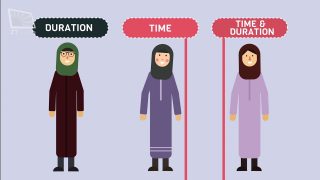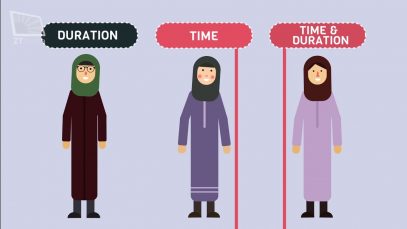Ahkam in Brief – Congregational Prayers
[The Script]
Ahkam in Brief – Congregational prayers
Congregational prayers is one of the symbols of Islam and Muslims. It is narrated that if the members of a congregational prayers exceeds ten, no one except Allah would be able to count the reward of their prayers.
In this video we will talk about the rules related to the congregational prayers.
Congregational prayers can easily be conducted by a group of people. The main criteria is that the leader or the Imam should have some characteristics for others to pray behind him.
So what are these characteristics?
First he should be at the age of puberty, sane and Shia
Secondly, his prayers should be correct according to the followers’ jurist.
Thirdly, his Arabic recitation of al-Fatiha and the Surah of Quran should be accurate.
Fourth, he should be Adil or just. This means he should follow the Islamic rules and refrain from sinful acts. Praying behind a person whom you are not sure whether he is just or not, is not allowed.
Fifth, he should also be of legitimate birth and not have been convicted or punished by Islamic laws. Some jurists stipulate that the parts of Sajda of the Imam’s body shouldn’t be amputated.
And finally men can’t pray behind a lady. And a person who offers prayers standing, cannot follow an Imam who offers his prayers while sitting.
How can one become assured that the Imam of congregational prayer is just or Adil?
This can be proven by personal acquaintance with the Imam, and to know that he performs all his religious duties and refrains from all forbidden acts according to the Islamic laws.
Another way is by the testimony of two just people that he is a just person.
And finally it can be proven by the widespread news amongst people which makes one assured that this person is just.
To hold congregational prayers these guidelines should be followed.
First, all the followers should stand behind the Imam.
Second, there shouldn’t be a gap between the followers of more than the biggest possible human footstep.
Third, a follower should be linked with the Imam or with one of the followers. This link can be either from the front, right, or left sides.
Fourth, The place of the Imam should not be higher than the place of the follower. But if the place of followers is higher than the place of Imam, it is acceptable.
What Niyat or intention is compulsory for a congregational prayer?
The follower should have the intention that he is praying in congregation. But this is not compulsory on the Imam. So for example it is allowed that a person starts his prayers individually and after that, people join him and pray behind him in congregational prayer. Here the Imam had the intention to pray individually but the intention of the followers was to pray in congregation.
Important note, it is allowed for the follower to pray a different prayer than what the Imam is praying. The main idea is that both should be praying one of the daily obligatory prayers. So, for example you can pray you Asr prayers behind a person who is praying his Zohr prayers. Or you can pray Qadha or the compensation of your Zohr behind a person who is praying his Isha.
So, how congregational prayer is performed?
Once the Imam commences his prayers, all followers can begin their prayers.
The follower shouldn’t go ahead of the Imam in any of the acts of prayers. So he has to bow, prostrate and stand up following the Imam. But in recitations, the follower is allowed to go ahead of the Imam.
Note that following the Imam is compulsory and the prayer might be void if one deliberately goes ahead or delays his actions.
The follower has to perform all acts and recitations of the prayers. The only exception is reciting al-Fatiha and the second Surah and this is only if he joins the congregation from its beginning.
Question, what if one arrives late and the congregational prayers has already started? What can he do?
The rules of joining a congregational prayers has a lot of detail. We will try to give some general guidelines that will help you. We advise you to review and practice the rules with an expert.
The first guideline: If a person arrives late, he can join the congregational prayers. If the Imam is standing or bowing in Ruku, he can commence his prayers and join them from where they are.
Note that if the Imam was bowing, the follower, after Saying Allahu-Akbar, must pause for a moment then bow down and join the congregation in Ruku. This pause is one of mandatory parts of any prayers.
The second guideline: If one joins the congregational prayers during the first or the second Rakaa before Imam raises his head up from Ruku, he doesn’t have to recite al-Fatiha and the second Surah for his first Rakaa. He would say Allahu Akbar, pause for a bit and go straight to Ruku.
The third guideline: If one joins the Imam in the third or fourth Rakaa, he should recite al-Fatiha and the second Surah. If this recitation causes him to fall behind the Imam, he can discontinue his recitation and bow down with Imam for the Ruku.
Important note that if before starting his prayers, one knows that he won’t be able to finish the recitation of Al-Fatiha, he must wait until Imam bows down for Ruku and then start his prayers.
The fourth guideline: If the Imam reached Tashahud and the new follower is not at the stage of Tashahud, he has to wait by taking a ready-to-stand position and wait till Imam stands up. He then can join the congregation at that point.
The same applies in the place of Salam. If the Imam is completing his prayers by reciting Salam and the new follower is not at the stage of Salam, he can take a ready-to-stand position till Imam ends his prayers. After that he can resume his prayers Furada or singly.
Finally the ladies’ congregational prayers rules
A woman can lead the prayer for other women. But she must stand in the same row along with other followers and she shouldn’t stand ahead of them.
However, when women take part in men’s congregational prayer, they must occupy the rear lines, or pray to the side, separated from the men with a barrier, such as a screen or curtain.














